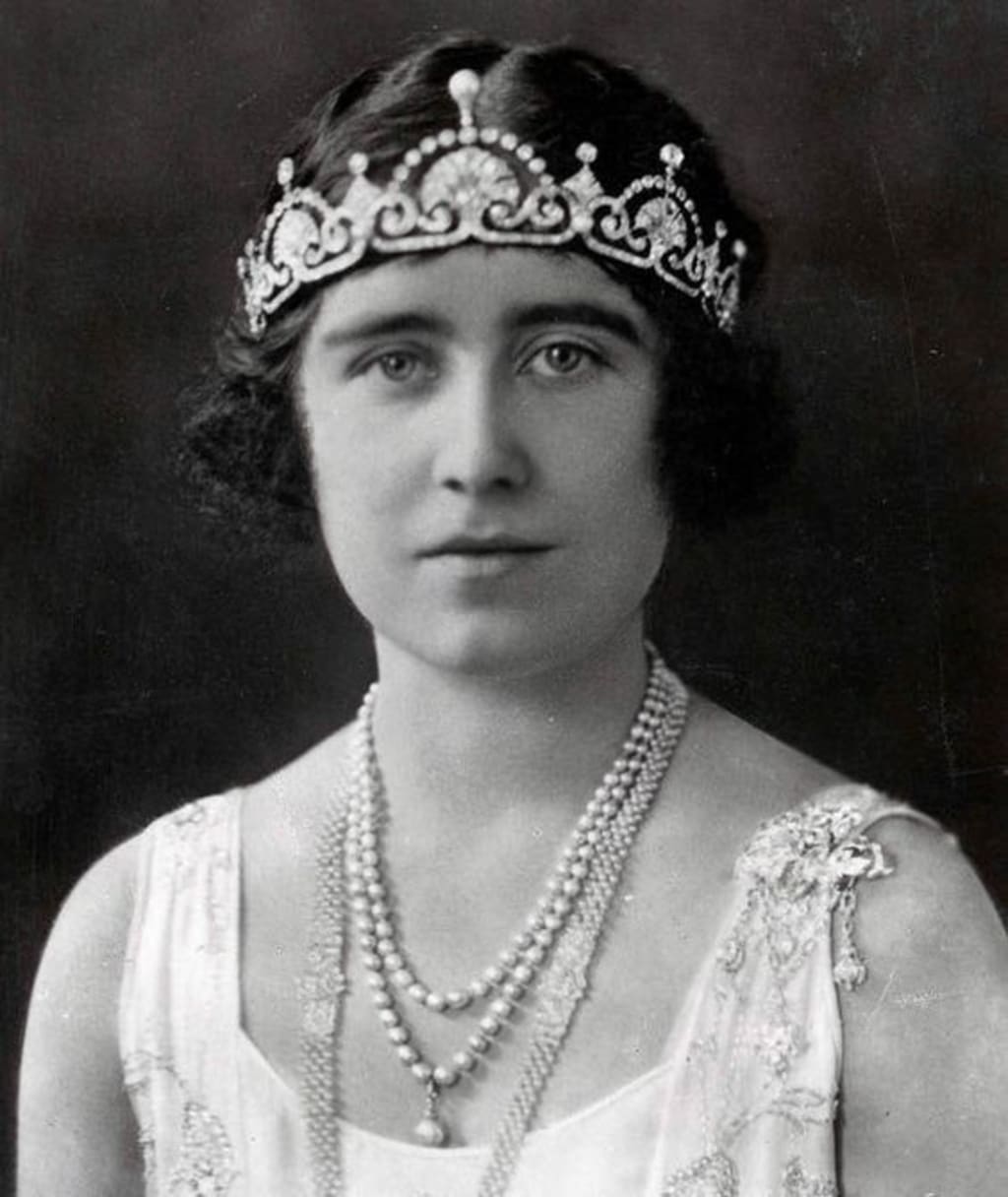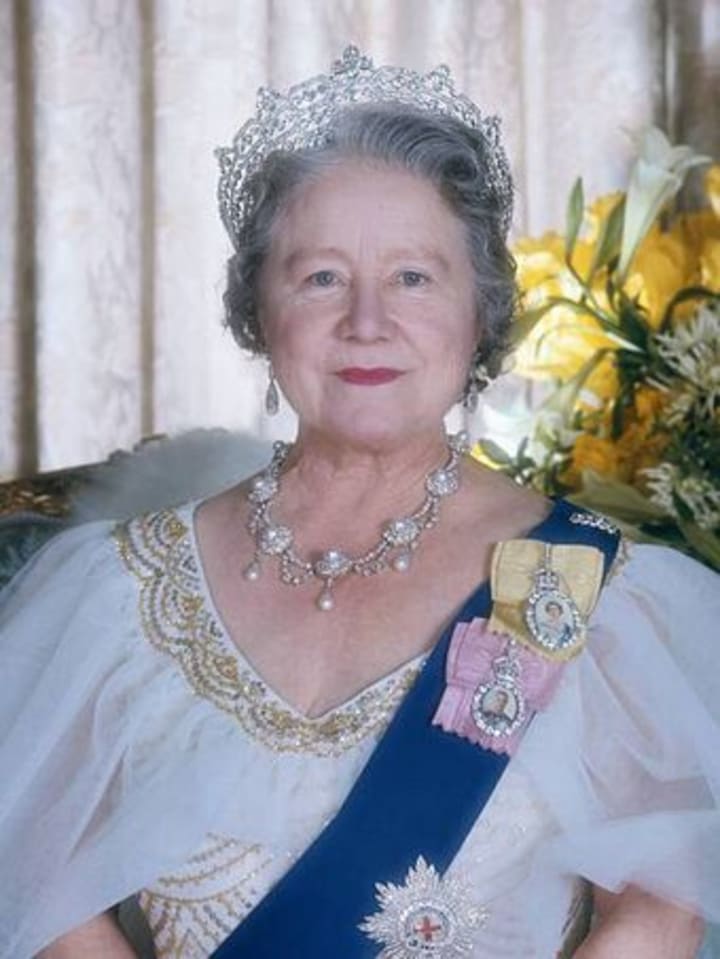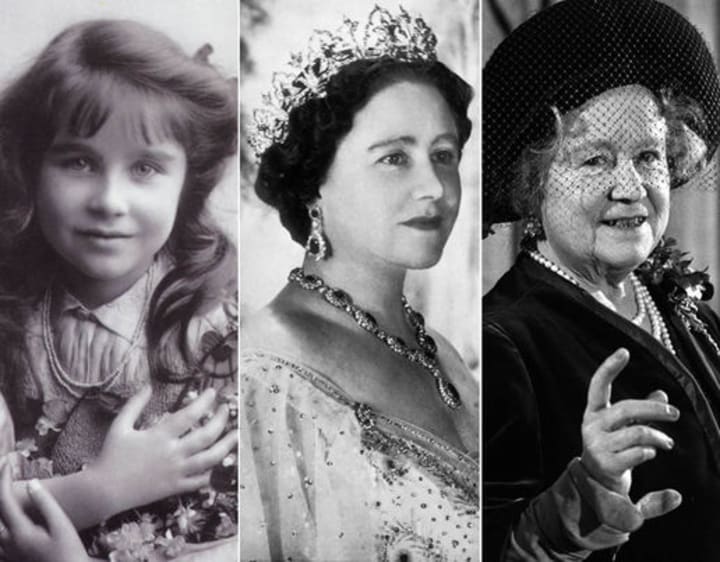The Queen Mother
Elizabeth Bowes-Lyon

The mother of our dear Queen Elizabeth II and Queen Consort to the late King George VI, the late Queen Mother was an example to us all. She is best remembered for her moral support to the British people during World War Two --- and her longevity --- as this Queen lived until she was 101 years of age!
This Queen’s life can be divided into two phases, (all of which teaches something about the ‘skill’ in being Royal). The first phase was from Elizabeth’s childhood to her Royal marriage --- she was brought up as a genteel, well-heeled Scottish ‘Lady,’ knowing that she must always put duty before her own personal wishes. The second phase was when she (reluctantly) married the then future King George VI. She really loved him but was very reluctant to ‘shoulder Royal rank.’ However, Elizabeth followed her heart, married the man she loved and (basically) showed us all how a Queen Consort should live.
The Honourable Elizabeth Angela Marguerite Bowes-Lyon was born on 4th August, 1900, the fourth daughter to Lord and Lady Glamis. Elizabeth was christened on 23rd September, 1900, in the local parish church, All Saints. She spent her early childhood in her parent’s country home at St. Paul’s Waldenbury, Hertfordshire (which is north of the capitol). When Lord Glamis inherited his Earldom in 1904, the Honourable Elizabeth became Lady Elizabeth Bowes-Lyon.
Descending from the Royal House of Scotland, one of Elizabeth’s 14th Century ancestors was Sir John Lyon, who became Thane of Glamis and Glamis Castle is the family seat.
Like most young ladies of the upper-classes, Elizabeth was ‘schooled’ at home by governesses and could speak French fluently, by the age of ten. Elizabeth was fond of field sports, ponies and dogs. When she started school in London, Elizabeth’s best subjects were literature and scripture. When she returned to private education, Elizabeth passed the Oxford Local Examination (with distinction) at the age of thirteen.
In her fourteenth birthday, World War One broke out and Glamis Castle became a hospital. Being too young to work as a nurse, Elizabeth did her best to keep ‘morale up’ by assisting with the welfare work for the patients. She would run errands for the wounded soldiers, going to the local shops to buy them cigarettes, tobacco and chocolates, as well as playing cards with them, Elizabeth always did her best, charming the wounded soldiers with her excellent company. Following her mother’s example, Elizabeth treated these soldiers as ‘houseguests’ and did her best to ‘raise their spirits.’ One of her brothers, Fergus, was killed during active service at the Battle of Loos in 1915.
Elizabeth and her older sisters had been friendly with King George V and Queen Mary’s children, with the Royal family occasionally staying Glamis Castle. In fact, Elizabeth was one of the bridesmaids at the wedding of Princess Mary in 1922.
“Bertie”, Prince Albert, (and the Duke of York) fell in love with Elizabeth and proposed to her in 1921. Although she loved Bertie, Elizabeth turned him down being: “afraid never, never again to be free to think, speak and act as I feel I really ought to.” The Prince would marry no one else. He proposed a second time, only to be turned down again. However, Elizabeth agreed to marry him on the third proposal, evidently in love with Bertie but having misgivings about Royal life. The engagement was announced in January 1923.

The young couple married at Westminster Abbey on 26th April, 1923. Elizabeth laid her wedding bouquet at the tomb of ‘The Unknown Warrior,’ this was unexpected as she was going into the Abbey. Elizabeth now became known as Her Royal Highness, the Duchess of York. After the wedding breakfast at Buckingham Palace (which was prepared by the chef Gabriel Tschumi), the young couple honeymooned at Polesden Lacey, which is a manor house in Surrey, and then they went to Scotland (where poor Elizabeth caught whooping cough). The wedding dress was made from deep ivory chiffon ‘moire,’ embroidered with pearls and silver thread. “It was intended to match the traditional “Flanders Lace” provided for the train by Queen Mary.” The fashion of the dress was of the early 1920’s and was designed by Madame Handley-Seymour, who was the dressmaker to Queen Mary. The design was based on a dress created by Jeanne Lanvin and was a ‘suggestive’ of a Medieval Italian gown. Choosing not to wear a tiara, Elizabeth instead wore a chaplet of leaves which secured the veil. A strip of Brussels lace, inserted in the dress, was a Strathmore heirloom. Prince Albert, “Bertie,” wore RAF full dress in the rank of group captain, his senior service rank at the time of the wedding.
After a successful visit to Northern Ireland in July 1924, the Duke and Duchess of York toured East Africa from December 1924 to April 1925. They visited Aden, Kenya, Uganda and Sudan, but avoided Egypt because of political tensions. Elizabeth helped Albert through therapy (after October 1925), as he had a stammer and was helped by the therapist Lionel Logue.

The young couple had their first child, little Princess Elizabeth, “Lilibet” (within the family) in 1926. Her sister, Princess Margaret, was born on 21st August, 1930.
In 1936, King George V (Elizabeth’s father-in-law) died and Edward, Albert’s elder brother, became King Edward VIII. King George V, when alive, had private doubts about his elder son, saying: “I pray God that my eldest son will never marry and that nothing will come between Bertie and Lilibet and the throne.” Just a few months into the new reign, Edward was determined to marry Wallis Simpson, who was an American divorcee. As Head of the Church of England, he was ‘not allowed’ to marry a divorced woman. Carrying on with his personal plans to marry the woman he loved, Edward chose to abdicate.
Albert now became the King of England on 11th December, 1936. King George VI and Elizabeth, the Queen Consort, were crowned on 12th May, 1937, at Westminster Abbey. The young couple were now the King and Queen of Great Britain, Ireland and the British Dominions, also the Emperor and Empress of India. Between the Coronation and the outbreak of World War Two (September 1939), the new King and Queen made two important visits --- in July, 1938, to France and in June, 1939, to Canada and the U.S.A.

At the start of this War, it was ‘mentioned’ that Elizabeth should take the two Princesses and evacuate to North America or Canada. Elizabeth’s reply was: “The children won’t go without me. I won’t leave the King. And the King will never leave.” Thus, the Royal family ‘stuck it out’ with the rest of the country, sharing with their people the same dangers and difficulties. When Buckingham Palace was bombed in September 1940, Elizabeth said: “I’m glad we’ve been bombed. It makes me feel I can look the East End in the face.” The young family ‘were in residency’ at Buckingham Palace at the time. This showed Queen Elizabeth’s courage, who Hitler is said to have called “the most dangerous woman in Europe.”
During this War, Elizabeth would visit troops, hospitals, factories and those parts of Britain that had been targeted. She wore her ‘best’ clothes, Norman Hartnell designing and dressing the Queen in gentle colours (avoiding black) to represent “the rainbow of hope.”
After World War Two had finished, George VI and Elizabeth went on an extensive tour of South Africa (1947). The 1948 tour of Australia and New Zealand had to be postponed because the King was ill. In the summer of 1951, Elizabeth and the Princesses ‘took on’ the King’s public engagements. In September of the same year, he was diagnosed with lung cancer. The last public occasion the King and Queen attended together was the opening of the Festival of Britain in May 1951.
In the autumn of 1951, the Princess Elizabeth and her husband, the Duke of Edinburgh (Prince Philip) took the King and Queen’s places on a tour of Canada, and also the following January, 1952, to Australia and New Zealand. It was during this tour that King George VI died peacefully in his sleep, at Sandringham House, Norfolk, on the 6th February, 1952.

Elizabeth, who was now “Her Majesty, Queen Elizabeth, The Queen Mother,” was devastated by her husband’s death and (like Queen Victoria before her), she retired from public life to Scotland. A meeting with the then Prime Minister, Winston Churchill, encourage Elizabeth to resume her ‘public duties.’ The Queen Mother was now as busy as when her husband was alive. One of the lovely ‘duties’ was in 1957, when the Queen Mother was inaugurated as the College’s President. When her daughter, Queen Elizabeth II, went on the extensive tour of the Commonwealth (1953-54), the Queen Mother acted as a “Counsellor of State” and also looked after her grandchildren, Charles and Anne. In February, 1959, the Queen Mother herself visited Kenya and Uganda.
She oversaw the restoration of the remote Castle of Mey (which is on the north coast of Scotland), which the Queen Mother used as a “get away from everything” for 3 weeks in August and 10 days in October every year. The Queen Mother is known for her love of horse racing, especially steeplechasing, in fact she owned several winners.
Over the years, this beautiful Queen Mother has had several operations --- an emergency appendectomy, removal of a tumour (she was diagnosed with colon cancer), and also a lump removed from her breast (breast cancer).
Even as a widow, Elizabeth treated everyone she met with respect. When she visited Iran, the British ambassador noted how the Iranians were ‘bemused’ by her habit of speaking to everyone --- no matter what their status or importance --- the Queen Mother paid attention to ordinary people.
As the years went on, the Queen Mother now became known for her longevity. When Elizabeth turned 100 years of age, there was a parade that celebrated her life and her image appeared on a special commemorative £20 note issued by the Bank of Scotland, as well as many other Birthday ‘gifts.’
Elizabeth attended her second daughter’s funeral (Princess Margaret). The Queen Mother was 101 years of age. She now retreated to the Royal Lodge as her health was declining rapidly.

Elizabeth, the Queen Mother died on 30th March, 2002, in her sleep at the Royal Lodge, Windsor Great Park. Her eldest daughter, Queen Elizabeth II, was by her bedside. An estimate 200,000 people filed past as she lay in state in Westminster Hall in the Palace of Westminster. An arrangement of camellias from her own gardens, were placed on the coffin. At one point, the four grandsons --- Prince Charles, Prince Andrew, Prince Edward and Viscount Linley --- mounted the guard, standing guard at the four corners of the “Catafalque,” as a mark of respect. This was an honour similar to the “Vigil of the Princes” at the lying in state of King George V (Elizabeth’s father-in-law). The Queen Mother was laid to rest beside her husband in St. George’s Chapel, Windsor Castle. At Elizabeth’s request, the funeral wreath was placed on the Tomb of the Unknown Warrior, even as her wedding bouquet had been.

My research comes from Wikipedia / Royal UK / “The Queen Mother = A 90th Birthday Tribute” by Anthony Holden.
About the Creator
Ruth Elizabeth Stiff
I love all things Earthy and Self-Help
History is one of my favourite subjects and I love to write short fiction
Research is so interesting for me too






Comments
There are no comments for this story
Be the first to respond and start the conversation.